Featured Articles Archive
Report on the February 14 Congregational Meeting
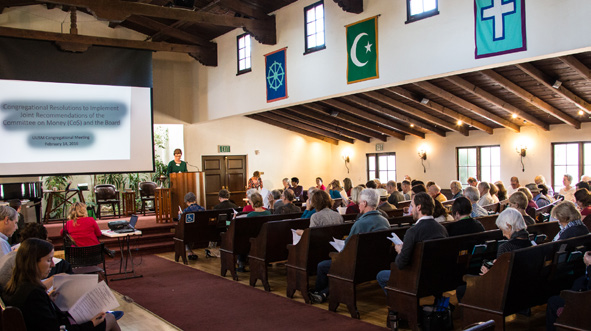 All of the resolutions presented jointly by the Committee on Money and the Board were approved by the approximately 80 members who attended the February 14 Congregational Meeting. They are:
All of the resolutions presented jointly by the Committee on Money and the Board were approved by the approximately 80 members who attended the February 14 Congregational Meeting. They are:Financial Framework Resolutions approved
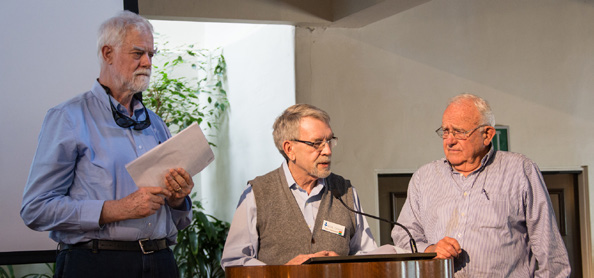 The Resolutions proposed by the Committee on Money and jointly recommended by the Board of Directors were passed by overwhelming margins at the Special Congregational Business Meeting held on Sunday February 14, 2016. This meeting was held as mandated by a resolution at our May 2015 Annual Business Meeting. The Committee on Money presented its report on church finances as charged by the congregation at its May 2014 Annual Business Meeting and was discharged from duty at the conclusion of the meeting. Their report consisted of the initial Recommendations presented at the April 2015 Town Hall, a summary of those recommendations at the May Annual Meeting, as well as the Resolutions to Implement the Recommendations, which were approved at this meeting.
The Resolutions proposed by the Committee on Money and jointly recommended by the Board of Directors were passed by overwhelming margins at the Special Congregational Business Meeting held on Sunday February 14, 2016. This meeting was held as mandated by a resolution at our May 2015 Annual Business Meeting. The Committee on Money presented its report on church finances as charged by the congregation at its May 2014 Annual Business Meeting and was discharged from duty at the conclusion of the meeting. Their report consisted of the initial Recommendations presented at the April 2015 Town Hall, a summary of those recommendations at the May Annual Meeting, as well as the Resolutions to Implement the Recommendations, which were approved at this meeting.The Chorus of Life: A Blessing of the Animals 2016


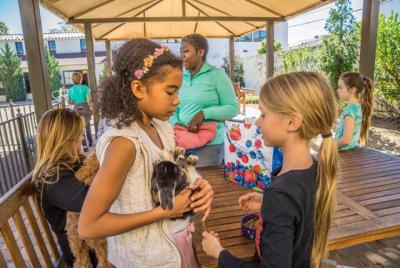
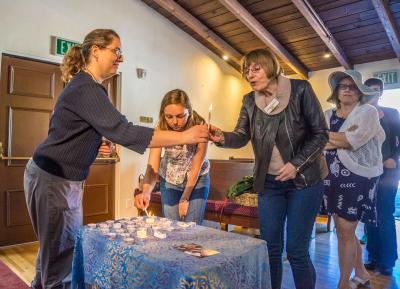

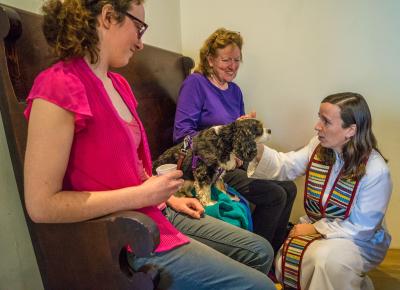
From the Committee on Ministry
Join us for Congregational Conversations Our Congregational Conversations are just a few weeks away. We are delighted by the enthusiastic response to this effort. If you haven’t signed up yet, there is still room, and we are hopeful that you will join us. It is vital that all of us are part of this important conversation. The focus groups are scheduled for Saturday, February 20; Sunday afternoon, February 21; and Monday evening, February 22 and will take place here at church.
You may recall that during the fall of 2014 the Committee on Ministry conducted a survey — something we thought of as a continuing conversation with our congregation. Though the response was small, we learned some of us are happy with our church and some of us were disappointed and unhappy. And we were reminded that all of us, regardless of the level of happiness or the issue at hand, love this church of ours.
In an effort to continue this conversation and better understand our concerns, we are working with UUA Regional Congregational Life Staff to convene a series of Congregational Conversations — one-hour focus groups designed to help us evaluate these concerns. These Congregational Conversations are part of UUA-endorsed steps toward bringing our community to more open communication, compassion, and healing and toward better understanding our joys and concerns.
The Congregational Conversations will consist of focus groups of 8 to 10 people, led in conversation by Regional Staff who are experienced and skilled in facilitating groups. These focus groups will not be led by members of our congregation. Focus group questions will be open-ended, designed to provide members the opportunity to communicate their concerns. Ground rules will provide guidance for fair, respectful communications. After the focus groups have been convened and completed, UUA Regional Staff will prepare a written report reflecting what we said during the focus groups, and will provide recommendations for our next steps. The report will be made available first to the Committee on Ministry and the Board and will then be shared with the congregation.
Please stop by the Committee on Ministry table in Forbes Hall after services for additional information and sign up.
If you know that you will not be able to attend any group in the times available, please contact committeeonministry@uusm.org and we will set up a one-on-one conversation for you with our trained UUA facilitators. Please bring your children; childcare will be provided.
Let us come together to honor one another in this beloved community of ours. As Rev. Rebecca said, your voice is vital to the success of our Congregational Conversations and will significantly shape our future together.
— Committee on Ministry
Money Resolutions Endorsed by the Board
The Board of Directors and the Committee on Money have come to unanimous agreement on the wording and substance of the proposed congregational resolutions to implement the recommendations of the Committee on Money. All members of the Board voted in favor of endorsing the resolutions. These resolutions are now jointly recommended by the Board and the Committee on Money.
Agreement followed weeks of meetings of the Committee on Money with the president, the treasurer, and others. A final hour of discussion and collaboration at the January 12 Board meeting with representatives of the Committee on Money provided clearer wording of the resolutions that achieved agreement.
Clarity was needed that only the congregation, at a Business Meeting (annual or special) held according to the bylaws, may authorize changes to the purposes established for each reserve fund by congregational resolutions, as reflected in any use, transfer, or withdrawal of funds from these reserves.
The authority of the Board to use the funds of any (congregational) reserve account for their defined purposes was affirmed. Also, Resolution IV provides that other (Board) Reserve Accounts may be established and managed by the Board to provide for other contingencies as well as for clear reporting of other approved or anticipated expenses of $5,000 or more.
— Steve White
From Our Pledge Team: 59 Raise Their Pledges; More Needed to Balance Budget
The 2016 Pledge Campaign kicked off in October with 9 house parties graciously hosted by members of our congregation. The purpose of these parties was several fold: (1) to get to know each other better and build community, (2) to talk about what nurtures us in the church and what we can do better, and (3) to talk about how our financial contribution or pledge supports our congregation. These house parties were attended by approximately 60 members and friends. Although each party was slightly different based on the number of people attending (from 4 to 12) and how the host led the meeting, the feedback that we received was overwhelmingly positive. People enjoyed the opportunity to be together (with food and drink, of course!) and to share their feelings about what they loved about our congregation. If you weren’t able to attend one of these parties, you may be able to experience this kind of gathering in the future — the Pledge Team is considering having them again next year.
The Pledge Campaign this year also included a drive to donate the entire Pledge Team’s operating budget ($2,000) to the Westside Food Bank. We donated $5 for every pledge card turned in, and, $10, $15, or $20 for every pledge increase of 3%, 5%, or ≥10%, respectively. Because of the congregation’s generosity (including 59 members/friends who increased their pledge), at the end of the campaign, we had collected $1,425 for the Westside Food Bank and $280,804 in pledge commitments! At the end of the year, we also “roll-over” the pledge of any member in good standing who did not turn in a pledge card (this practice is church policy). This year, 52% of members pledged and the remaining 48% were considered roll-overs. When we include these roll-overs, our pledge commitments are approximately $396,000. However, if we are conservative with the numbers, and consider that 15% of actual pledges will not be collected (in a typical non-profit, the fulfillment rate is 85 to 90%), our “dependable” pledges are actually $336,600, which will fund more than 50% of our typical budget. Way to go, congregation, and thank you for participating in our pledge drive this year!
— Your Pledge Team: Barbara Gibbs, Gretchen Goetz, Kit Shaw, Kim Miller, Beth Brownlie, Jacki Weber, Abby Arnold, and Rev. Rebecca Benefiel-Bijur
Thank You to All 2016 Pledgers:
Eve and Bill Ahlers, Kenneth Alexander, Beverly Alison, Farrokh and Garland Allen, Abby Arnold, Jeremy Arnold, Kirk Attebury, Bettye Barclay, Francois Bar and Alison Kendall, Susan Bickford and Daniel Nannini, Jonathan and Rebecca Bijur, Harvey and Sheila Bjornlie, Edna and Phillip Bonacich, Teri Bond, Bonnie Brae, Leslie Beauvais and Ed Brand, June Bray, Anita and George Brenner, Christopher Brown, Helen Brown, Beth Brownlie and Bryan Oakes, Alan and Amy Brunell, Patrick Burrows and Nancy Shinno, Leonard Cachola, Karen Canady, Teresa Castelli, Jessica Clay, Kathy Cook, Cynthia Cottam and Tom Early, Rebecca Crawford, Dorothy and Phillip Curtis, Steven DePaul and Beth Rendeiro, Janine Venable deZarn, Bob Dietz and Ellen Levy, James and Emily Duckman, Melinda Ewen, Sanna Egan, Sarah Edgington, Joe Engleman, Michael Eselun, Jan and Bruce Ferguson, Olga Felton, Dwight Flowers, Resa Foreman, Roberta Frye, Vicky Foxworth and Jeff Pressman, Clayton Fosset, Norbert Gallery and Rima Snyder, Steve Garboski, Catherine Gentile, Barbara Gibbs, Wendi Gladstone, David and Gretchen Goetz, Marion Goldenfeld, Melissa Goodnight, Patricia Gomez, Raymond Goodman, Janet Goodwin and Karl Lisovsky, Elaine Gordon, Rayma Greenberg, Lucy Hahn, Alice Hall, John and Sharon Hart, Sarah Mae and Hugo Harper, Nora Hamilton, Charles and Christine Haskell, Denise Helton, Leon and Nicole Henderson-MacLennan, Emily Hero, Gerry Hurst, Carl Hoppe and Diane Fletcher-Hoppe, Larry Howard, Nancy and Glen Howell, Mark Huberman, Jay Johnson and Rachel Sene, Cynthia Kelly, Barbara Kernochan, Margaret and Yacoub Kharraz, Phyllis and Robert Kory, Geralyn Lambson, Kris Langabeer and Debbie Menzies, Carl and Ann Levken, Anne MacQueen, Katie Malich, Eileen and Michael McCormak, Joyce and Warren Matthews, Laura Matthews, Richard and Patricia Mathias, Patrick McGuire, Patrick Meighan and Amy Thiel, Ralph Meyer, Kim Miller, Liam Mina, Diane Monteith, Jerry and Sue Moore, Francine and Stuart Moore, Helene and James Morison, Toshi Nakajima and Wendy Snyder, Susana Nierlich, Bryan and Beth Oakes, David and Kitsy Olson, Christine Ong, Vilma Ortiz, Tony Patel, Dan and Karen Hsu Patterson, Rhonda Peacock, John Penney, Jo An and Tom Peters , Ernest Pipes, Allen and Ruth Potts, Barbara Powers, Joan Reitzel, Leslie Reuter, Rick and Peggy Rhoads, Norman Richey and Beverly Shoenberger, Carol Ring, Elaine Roark, Scott Roewe, Anne Saldo, Kit Shaw, Andrea Steffan, Temitope Sonuyi, Marguerite Spears, Diana Spears, Dorothy Steinicke, Isabel and Bayard Storey, Susan Stoyanoff and Steve White, Ellen Stuart, John Sussman, Christine and Mark Rizzo Suarez, Jila Tayefehnowrooz and Mansour Ariomandi, Pamela and Rick Teplitz, Erika and Steven Valore, Linda Van Ligten and Greg Woods, Kay Ward, Jacki Weber, Jennifer Westbay, Jesamine Winston, Joanna Woods-Marsden, Edward and Patricia Wright, Stephen and Sylvia Young, Michael Young, Joan Zierler, John Zinner
Quotes About Vocation:
 Bettye Barclay has provided this list of quotes about our ministerial theme for February. Daily quotes also appear in the weekly electronic announcements.
Bettye Barclay has provided this list of quotes about our ministerial theme for February. Daily quotes also appear in the weekly electronic announcements.
Week 1. I think it would be well, and proper, and obedient, and pure, to grasp your one necessity and not let it go, dangle from it limp wherever it takes you. —Annie Dillard
Week 2. If you find what you do each day seems to have no link to any higher purpose, you probably want to rethink what you are doing. —Ronald A. Heifetz
Week 3. It is not more vacation we need — it is more vocation. —Eleanor Roosevelt
Week 4. The only way to do great work is to love what you do. If you haven’t found it yet, keep looking. Don’t settle. As with all matters of the heart, you’ll know when you find it. And, like any great relationship, it just gets better and better as the years roll on. So keep looking until you find it. Don’t settle. —Steve Jobs
Week 5. Choose a job you love and you will never have to work a day in your life. —Confucius
COMMITTEE ON MINISTRY:
Congregational Assessment
One purpose of the Committee on Ministry is to consider the health of our church community. In recent months we have become aware of conflict and unhappiness among members of our church. In an effort to better understand these concerns, the Committee on Ministry is working with UUA Regional Congregational Life Staff to convene focus groups designed to help us evaluate these concerns. These one-hour focus groups are scheduled for Saturday, February 20 to Monday, February 22. The focus groups will be led by Ken Brown, our UUA Congregational Life Staff member, and multiple UUA Regional Consultants.
The focus groups are part of UUA-endorsed steps toward bringing our community to more open communication, compassion, and healing. Everyone is encouraged to participate in order to ensure a fair, representative, and compassionate process.
From a historical perspective, a year ago the Committee on Ministry conducted a survey — something we thought of as a continuing conversation with our congregation. Though the response was small, we learned from a few courageous people there was and continues to be unhappiness among us. And we were reminded that all of us, regardless of the level of unhappiness or the issue at hand, love this church of ours. In the months since, we have heard from more of our members and friends, and conflict, unhappiness, hurt feelings and sorrow continue to be important issues.
The initial UUA-led assessment will consist of focus groups of 8 to 10 people, led in conversation by Regional Staff. These focus groups will not be led by members of our congregation. Focus group questions will be open-ended, designed to provide members the opportunity to communicate their concerns. Ground rules will provide guidance for fair, respectful communications. There will be many focus groups, scheduled over many different days and times, to accommodate all who wish to participate. After the focus groups have been convened and completed, UUA Regional Staff will prepare a written report reflecting what we told them during the focus groups, and they will provide recommendations for our next steps. The report will be made available first to the Committee on Ministry and the Board and will then be shared with the congregation.
Please stop by the Committee on Ministry table in Forbes Hall after services throughout January for additional information. We will be there every Sunday, and there will be many other opportunities to learn about this important, nurturing endeavor.
Let us come together to start the healing process and honor one another in this beloved community of ours. Respectfully submitted,
— Committee on Ministry: Leon Henderson-MacLennan; Barbara Kernochan; Margot Page; Tom Peters, Co-Chair; Sue Stoyanoff, Co-Chair; and the Reverend Rebecca Benefiel Bijur
FROM THE COMMITTEE ON MONEY:
December 6 Meeting Summary and Recommendations
81 ATTEND TOWN HALL MEETING ON MONEY; YOU CAN SEE THE POWERPOINT BEFORE THE FEBRUARY 14 VOTE.
On December 6, the Board, led by our president, Patricia Wright, presented a PowerPoint summary followed by discussion of the proposed motions prepared by the C on $. Ron Crane, David Olsen, Vicki Foxworth, and Steve White from the C on $ were present and responded to questions.
To recap, the background of the formation of the Committee on Money (C on $) evolved as our church received some very large and unique bequests and donations over the past five years or so. There were two types of bequests: 1) the member leaving us the money “directed” or restricted what it could be spent on, and 2) the member leaving or giving the money did not restrict its use, generally called “unrestricted reserves.” At the May 2014 annual meeting, the congregation voted to appoint the C on $ to research, evaluate, and make recommendations as to how we should handle these unique financial donations.
It was noted that approximately half of the $880,000 we originally had in unrestricted reserves has already been spent or is now set aside to pay for projects already approved by the congregation, such as the $80,000 set aside to update the lighting and sound system in the sanctuary. (Note: A separate accounting is being prepared setting forth the expenditures of the prior unrestricted reserves.) Although some of the funds were spent on much delayed repairs and maintenance, it is projected that there will be approximately $430,000 of the “unrestricted reserves” left by June 30, 2016.
In summary, the PowerPoint highlighted that, if the C on $ resolutions pass, there will be an endowment and four separate “reserve funds” created as follows:
TYPE OF ACCOUNT AND INITIAL ALLOCATIONS
1. Catastrophe reserve - $150,000 with a goal of $750,000
2. Capital building reserve - $50,000 with a goal of $250,000
3. Contingency reserve - $30,000 with a goal of $30,000
4. Endowment Fund - $150,000 with a goal of $2,000,000
5. Budget deficit reserve - $50,000 (for 2016-17 fiscal year)
A lively discussion, with comments, questions, and answers followed. There were several questions regarding the large deductible for the earthquake insurance coverage. The explanation is that UU Santa Monica is lucky in that we are “grandmothered in” for earthquake coverage for the main church building. However the deductible for earthquake coverage is 25% of the damage. (The Cottage cannot be covered by earthquake insurance as no insurance carrier will provide coverage for commercial buildings in California.)
There were questions regarding the use of these funds for the past several years to make up a yearly deficit budget. In May 2015 the congregation voted to use another $52,000 for the current fiscal year (which ends on June 30, 2016), and the Finance Committee and the C on $ anticipate in their motions that we will need at least another year to work towards a sustainable budget at our church where our annual income closely matches our budget. Members expressed concern that we are using our unrestricted reserves to supplement our annual budget.
Several questions pertained to the implementation of the endowment, and if, as a congregation, we could “undo” the endowment if we need the funds or change our minds. The C on $ representatives confirmed that our congregation can dissolve or withdraw principal from the endowment by a 2/3 vote of the congregation. The C on $ explained that the amounts in the reserve accounts could be moved or changed by a vote of the congregation or by the Board, depending on the amount of money being rebudgeted.
Patricia Wright took the lead in preparing the PowerPoint and worked in collaboration with the C on $ representatives, Ron Crane (chair), David Olsen, Ken Alexander, Vicki Foxworth, Leslie Reuter, and Steve White (recording secretary for C on $) as well as Kim Miller, Treasurer. Steve White drafted the voter summary for the C on $ resolutions. 81 people attended the town hall meeting.
Copies of the Committee on Money resolutions and voter summary as well as the PowerPoint itself are in the church office. If you would like this information sent to you by email attachment, please request it from Nurit Gordon in the church office. Everyone is encouraged to review these documents now and well in advance of the February 14, 2016, business meeting vote on the Committee on Money’s resolutions. Anyone with further questions may direct those to any member of the C on $, or Kim Miller .
— Kim Miller
Numbers at the UU Church of Santa Monica
One way of measuring the health of our church is to consider quantitative indicators of financial status, membership, and attendance. These kinds of measures cannot replace qualitative indicators: do congregants feel fulfilled, happy, and satisfied with the direction of the church? Nevertheless, numbers can be helpful.
PURPOSE. This report, which is available on request from the church office, presents numbers for membership and financial status from 2008 to 2015 and for attendance over time from 2011 to 2015. These numbers address whether these indicators are declining, stable, or increasing.
SUMMARY: First, attendance shows a slight decline between 2010 and 2014. Membership and pledges are relatively stable between 2010 and 2014. Second, rental income and other giving have increased. Third, expenses have increased rapidly and consequently there are larger deficits. Fourth, there is an increase in income given per member and even greater increase in expenses per member.
IMPLICATIONS: Based on these numerical indicators, the church appears to be stable but is not growing in membership or attendance. Stable pledge income has implications for the kind of spending plan that the church implements. Because pledges are not increasing at the rate of expenses, it would be prudent to decrease expenses. On the other hand, the question of how to cut expenses (which would likely affect staff and salaries) is beyond the scope of this report.
— Vilma Ortiz
 FROM A MEMBER OF OUR FINANCE COMMITTEE:
FROM A MEMBER OF OUR FINANCE COMMITTEE:
When Will We Adopt a Sustainable Operating Budget?
A sustainable church budget is important because it doesn’t push problems into the future. When we spend more on operating expenses than our current income, we must withdraw money saved from prior years’ income or inherited previously. That is not prudent because future bequests are unpredictable. Bequests are best used for endowments, contingency reserves, and building (“capital”) improvements.
During the fiscal year ending June 30, 2015, we took about $60,000, or $5,000 per month, from our legacy (bequest) funds to pay our regular operating expenses. We’ve been doing this since 2008-2009, the year of the Great Recession, when we spent $2,445 per month on income shortfalls. We’ve gotten in the habit of doing so — living beyond our means — every year since, except for 2009-2010.
At our congregational meeting in May, we voted to approve and accept a budget that will require us to take up to $52,000 more from our one-time legacy funds by next June to pay recurring expenses.
However, as of November 30, we were on pace for a projected $87,000 deficit by June 30, $35,000 more than the Congregation has authorized. While we work and hope for a major improvement in pledging, fiscal year-to-date pledge receipts through November 30 are more than $10,000 lower than for the previous three years! Prudent management says that spending savings for current expenses only makes sense when there is a specific plan in place to get back in balance as soon as possible after a sudden shock. However, our leaders have advocated that we must maintain the vitality of our church and enable it to grow, regardless of our deficit, by maintaining the current, growing level of expenses. We’ve tried that for five years and it hasn’t worked — all trends are down.
To my knowledge, 18 months after the $72,000 deficit budget was approved in May 2014, specific plans for reducing expenses or increasing revenue have not yet been proposed or developed. The Garden of Eternity has been the only significant new or increased source of revenue, with 14 bricks at $500 each sold to date in addition to Ray Goodman’s initial $10,000 gift. Pledges have not increased over the last six years and membership has decreased yearly for the last 10 years. Annual expenses have steadily gone up.
Everyone knows that balance requires cutting expenses and/ or increasing income. Cutting expenses is hard when most of our budget pays for staff costs and fixed operating costs, but cutting had to be done in 2008 when the Great Recession of 2008 suddenly dropped our income. For me, cutting staff is a desperate measure when there are no other options. If we had not had legacy money in the bank, we would have had to cut staff for the last 18 months, or indeed for the last six years!
However, there are other options which have been used in the past and need to be considered. None are easy, as they are all worthy expenses, but we may prefer them to cutting staff or programs. It makes no sense to me to spend one-time money on recurring, annual expenses on a continuing basis. Let’s face reality, now, not later!
We currently send $25,000 per year in per-member dues to the UUA and the UUA district/regional offices. We have worked hard for years to bring both closer to 100% of our “fair share” per member, and are proud to have done so. Does it make sense to keep spending one-time bequest money to pay annual dues?
We generously and fairly approved $15,000 in staff raises for the current fiscal year, even though we didn’t know the total cost at the time. Does it make sense to spend one-time bequest money to pay for both this year’s raises as well as next year’s raises on top of this year’s?
We have had a wonderful Facilities Development Committee with volunteer professionals leading it for the last several years. This has been terrific, helping us recover from decades of deferred and neglected maintenance.
• We raised $200,000 to replace the leaky roof over the Sanctuary while bringing the north wall of the Sanctuary up to earthquake standards.
• We used $233,000 of Drew Still’s bequest to improve our administrative offices.
• We have used $200,000 of other bequests on building and campus (“capital”) improvements,
• Over the last seven years, we invested more than $630,000 in building improvements.
• This was on top of about $2 million raised by previous capital campaigns.
However, during these same seven years, we used $244,000 of bequest money (average of $35,000 per year) to pay for ordinary operating expenses! Do we really want to approve a third massive deficit of $50,000 or more for 2016-17 this coming May?
If all our operating expenses are considered vital by our congregation, why have we, the congregation, not raised enough money and made sufficient pledges to pay for them at any time over the last several years?
Our leadership must do more toward building financial support for their spending plans, or scale them back.
The choices are hard, but only get harder each passing year. I ask every member of our church community to consider our options to get us back on track to being a financially healthy and sustainable congregation. Let’s take action now, not later.
— Steve White
The Pledge Team will donate:
• $5 for every pledge card turned in by December 20
• $10 for 3% increase in your pledge
• $15 for 5% increase
• $20 for 10% or more increase
(We have collected $1,150 to date for the Food Bank)
Please take time now to make a financial commitment to our beloved community at a level that is deeply significant for you. And many thanks to all who attended house parties!
With gratitude from your Pledge Team:
Beth Brownlie, Barbara Gibbs, Gretchen Goetz, Kit Shaw, Kim Miller, Jackie Weber, Patricia Wright, Advisors: Abby Arnold, Rev. Rebecca Benefiel Bijur, Rev. Tera Little
UU SANTA MONICA MEMBERS AND FRIENDS WITH PLEDGES FOR 2016 RECEIVED IN DECEMBER:
Abby Arnold, Kirk Attebury, Francois Bar and Alison Kendall, Bettye Barclay, Rebecca and Jonathan Bijur, Harvey and Sheila Bjornlie, Bonnie Brae, Leslie Beauvais and Edward Brand, Christopher Brown, Helen Brown, Patrick Burrows and Nancy Shinno, Leonard Cachola, Teresa Castelli, Kathy Cook, Cynthia Cottam and Tom Early, Rebecca Crawford, Dorothy and Philip Curtis, Steven DePaul and Beth Rendeiro, Janine Venable deZarn, Bob Dietz and Ellen Levy, James Duckman and Emily Linnemeier, Sarah Edgington, Sanna Egan, Joe Engleman, Michael Eselun, Melinda Ewen, Jan and Bruce Ferguson, Dwight Flowers, Resa Foreman, Clayton Fossett, Vicky Foxworth and Jeff Pressman, Roberta Frye, Norbert Gallery and Rima Snyder, Steve Garboski, Barbara Gibbs, Wendi Gladstone, David and Gretchen Goetz, Marion Goldenfeld, Patricia Gomez, Melissa Goodnight, Janet Goodwin and Karl Lisovsky, Rayma Greenberg, Alice Hall, Nora Hamilton, Charles and Christine Haskell, Denise Helton, the Henderson-MacLennans, Emily Hero, Lawrence Howard, Glen and Nancy Howell, Mark Huberman, Gerry Hurst, Jay Johnson and Rachel Sene, Cynthia Kelly, Barbara Kernochan, Margaret and Yacoub Kharraz, Geralyn Lambson, Ann and Carl Lekven, Anne MacQueen, Katie Malich, Joyce and Warren Mathews, Patricia and Richard Mathias, Laura Matthews, Patrick Meighan and Amy Thiel, Ralph Meyer, Kim Miller, Liam Mina, Francine and Stuart Moore, Jerry and Sue Moore, Helene and James Morison, Susana Nierlich, Beth Brownlie and Bryan Oakes, David and Kitsy Olson, Vilma Ortiz, Tony Patel, Dan and Karen Hsu Patterson, Lorenzo Pelayo, the Rev. Ernest Pipes, Ruth and Allen Potts, Barbara Powers, Joan Reitzel, Leslie Reuter, Carol Ring, Elaine Roark, Scott Roewe, Anne Saldo, Kit Shaw, Catherine Gentile, Temitope Sonuyi, Diana Spears, Marguerite Spears, Andrea Steffan, Dorothy Steinicke, Isabel and Bayard Storey, Susan Stoyanoff and Stephen White, John Sussman, Jila Tayefehnowrooz, Pamela Teplitz and Rick Teplitz, Linda van Ligten and Greg Wood, Jennifer Westbay, Jessamine Winston, Edward and Patricia Wright, Michael Young, Joan Zierler, and John Zinner.
December Festivities
Friendly Beasts Christmas Pageant, led by Kris Langabeer
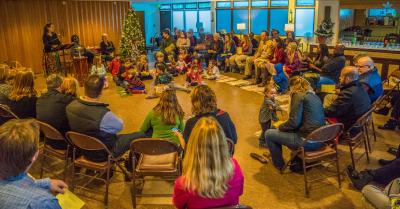

Christmas Eve Services
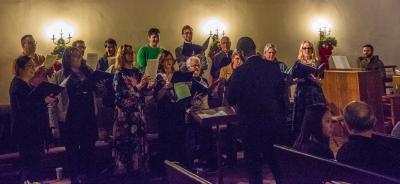
Photos from Our All-Church Thanksgiving Feast
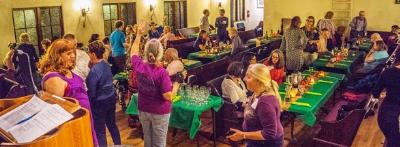
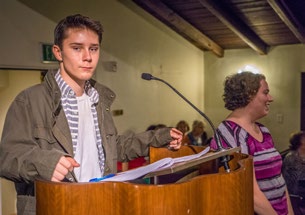
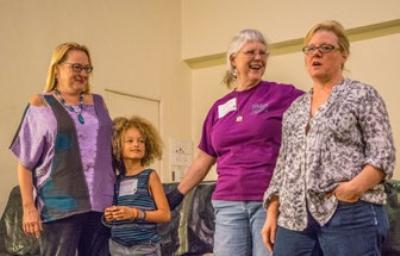
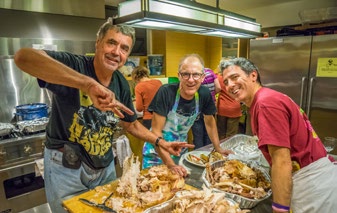
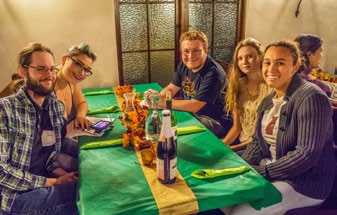

Committee on Ministry: Congregational Assessment
One purpose of the Committee on Ministry is to consider the health of our church community. In recent months we have become aware of conflict and unhappiness among members of our church. In an effort to better understand these concerns, the Committee on Ministry will be working with UUA Regional Congregational Life Staff to convene focus groups designed to help manage this conflict. We anticipate that these focus groups will take place during the first quarter of 2016. The focus groups will be led by Ken Brown, our UUA Congregational Life Staff member, and multiple UUA Regional Consultants.
Notes from the Town Hall Meeting on November 1: The congregation’s vision for the future
 From a Member of Our Finance Committee:
From a Member of Our Finance Committee:
$25 Per Month Creates a Sustainable, Balanced Budget Next Year
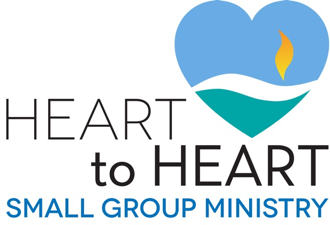 Heart to Heart Circles — Practicing What it Means to be Human
Heart to Heart Circles — Practicing What it Means to be Human
Jessica Chapin and the Garden of Eternity
 Quotes about Faith
Quotes about Faith
From Our Pledge Committee: Living our Commitment by Funding our Movement
 The Civil Rights Movement is an inspiration in so many ways — the women and men who drove each other to work for over a year during the Montgomery bus boycott; the brave youth who integrated the University of Georgia and other southern universities; the people who faced the police on the Edmund Pettis Bridge in Selma.
The Civil Rights Movement is an inspiration in so many ways — the women and men who drove each other to work for over a year during the Montgomery bus boycott; the brave youth who integrated the University of Georgia and other southern universities; the people who faced the police on the Edmund Pettis Bridge in Selma.
Searching for new ways to inspire financial giving in our beloved church, I found an article in the Grassroots Fundraising Journal describing how the Civil Rights Movement of the 1950s and 1960s raised the money to pay organizers, print posters and leaflets, feed demonstrators, and cover all the costs of building a massive social movement.
Like all authentic mass movements, nearly all of the funding came from contributions by the housekeepers, sanitation workers, and kitchen staff in the pews of the black churches where nightly meetings were held. The article, by Holly Fincke, quotes Reverend T.J. Jemison, leader and spokesperson for the Baton Rouge 1953 bus boycott as saying “The black citizens, mainly, and a few whites, contributed enough money to pay for all the tires, and batteries, and gas and my bodyguards. And we owed nobody nothing. The black community paid for all that.”
Similar experience in Alabama, Mississippi, and Georgia led one leader to say that it was “the black community that financed efforts aimed at its own liberation.” When funding did eventually come from national foundations, which happened later in the NOVEMBER 8 “Oh We Give Thanks” Rev. Tera Little, preaching NOVEMBER 15 “From Locusts to Honeybees” Rev. Tera Little, preaching NOVEMBER 22 “For this we are thankful?” Kikanza J Nuri-Robins NOVEMBER 29 “A Fish Out of Water” Kikanza J Nuri-Robins movement, “foundations put pressure on the movement to downplay more radical strategies,” writes Fincke. The Civil Rights Movement was able to raise the funds it needed from those who believed most deeply in the cause, most of whom had very limited means.
Like the Civil Rights Movement and virtually all churches, UU Santa Monica operates on the income we receive from our members and friends. Each member makes an annual commitment to donate meaningfully to our pledge income, which makes up more than three-fourths of our annual budget. Because we are an old church without a mortgage, nearly all of our expenses involve paying the wonderful people who staff our programs and maintain our infrastructure. The gasoline, batteries, and bodyguards of the early Civil Rights Movement are the salaries, supplies, and services of our church. If the members of the early Civil Rights Movement were able to support their movement from their own very modest pockets, shouldn’t we be able to do the same?
We’ll have an opportunity to talk about our involvement in Unitarian Universalism and our commitment to our church at a series of ten house parties organized by the Pledge Team in the next few weeks. It is a time for us to come together, as the people of Montgomery and Selma did, and share our personal stories about what brought us to our church, and how deeply we care about its future. I am looking forward to hosting one of these gatherings, when I will learn more about the people with whom I am building a beloved community on Sunday mornings.
My financial commitment to the Unitarian Universalist Community Church of Santa Monica supports our inspiring Sunday services, vibrant religious education programs, and social justice agenda. I’m so proud to belong to this church, and I’m happy to express my pride through an automatic monthly deduction from my bank account. I invite you to find a path to meaningful giving for the life of our church and our community.
— Abby Arnold
Heart to Heart Circles: Listen Up!
 Listening is powerful. When you listen to other people, you pay value to them and make them feel more important and worthwhile. Motivational speaker Philip Hesketh says “rapt attention is the highest form of flattery.” Yet how many of us feel that we get that “rapt attention”? Most people are so concerned with their next comment that they barely listen to one another. They merely wait for an opportunity to jump in when the other person takes a breath. People tend to spend more time evaluating what the speaker is saying or mentally composing their responses than they do actually listening. Listening is what makes Heart to Heart Circles a unique church program. Here, we gather together once a month to listen to one another share from the heart. Each month we have selected readings along with questions to consider regarding a particular topic. The circles give participants time to pause, reflect, speak what’s in their heart regarding the topic, and to hold the space silent while others share their truth. It requires tremendous discipline to listen attentively without interrupting. It is challenging to turn off your own mind and direct your attention completely to another person. As with most other social skills, to master listening, practice is required.
Listening is powerful. When you listen to other people, you pay value to them and make them feel more important and worthwhile. Motivational speaker Philip Hesketh says “rapt attention is the highest form of flattery.” Yet how many of us feel that we get that “rapt attention”? Most people are so concerned with their next comment that they barely listen to one another. They merely wait for an opportunity to jump in when the other person takes a breath. People tend to spend more time evaluating what the speaker is saying or mentally composing their responses than they do actually listening. Listening is what makes Heart to Heart Circles a unique church program. Here, we gather together once a month to listen to one another share from the heart. Each month we have selected readings along with questions to consider regarding a particular topic. The circles give participants time to pause, reflect, speak what’s in their heart regarding the topic, and to hold the space silent while others share their truth. It requires tremendous discipline to listen attentively without interrupting. It is challenging to turn off your own mind and direct your attention completely to another person. As with most other social skills, to master listening, practice is required.
“Listening is a very deep practice… you have to empty yourself. You have to leave space in order to listen.” —Thich Nhat Hanh
Listening builds trust. Attentive listening helps you learn more about other people. The more you listen to other people, and genuinely try to understand and empathize with them, the more you develop yourself. Each of us has something to say. Having the space to speak your truth without judgment or comment, is a gift we give to one another in Heart to Heart Circles.
Heart to Heart participants also complete two service projects as a group: one for the church community and one for the wider community. This year, registration for Heart to Heart Circles will take place during the month of December, closing on January 10. New groups for the 2016 session will begin in February. You are invited to participate!
— Rhonda Peacock
Quotes About Gratitude
 Bettye Barclay has provided this list of quotes about our ministerial theme for November. Daily quotes also appear in the weekly electronic announcements.
Bettye Barclay has provided this list of quotes about our ministerial theme for November. Daily quotes also appear in the weekly electronic announcements.
Week 1. Gratitude is the sign of noble souls. — Aesop
Week 2. We learned about gratitude and humility – that so many people had a hand in our success, from teachers who inspired us to the janitors who kept our school clean…and we were taught to value everyone’s contribution and treat everyone with respect. — Michelle Obama
Week 3. We must find time to stop and thank the people who make a difference in our lives. — John F. Kennedy
Week 4. Piglet noticed that even though he had a Very Small Heart, it could hold a rather large amount of Gratitude. — A. A. Milne, Winnie-the-Pooh
Week 5. For each new morning with its light. For the rest and shelter of the night, For health and food, for love and friends, For everything Thy goodness sends. — Ralph Waldo Emerson
From Our Treasurer: Defecit Spending
 1. Deficit spending so far for 2015/2016
1. Deficit spending so far for 2015/2016
The deficit so far is $34,876. This is contrasted to our “projected” year to date deficit of $24,233. However this deficit number also includes payment for chairs in the amount of approximately $9,500 from money deducted from the facilities maintenance fund so our actual deficit to date is approximately $25,376. Even assuming that our deficit is the $25,376, one way to project our anticipated deficit by the end of June 2016 would be $101,504. This is not the only way to roughly project deficit or spending but it is one way. As a community we can expect more incoming funds after the start of our annual fall pledge drive and by year-end as some members make a one-time or year-end pledge at the end of the calendar year. However the above number is roughly twice what the congregation approved in May of 2015 as a deficit.
We are starting our annual pledge drive and I hope everyone will consider increasing their pledge by a number that is meaningful to you and your family.
2. Status of pledges
Pledges are down by approximately $14,478 adjusted for seasonal variations.
3. Reduction of our unrestricted funds In May of 2014 we had approximately $661,000 in unrestricted reserves. However in projecting what has already been spent and/ or what is now “set aside” and authorized to be spent, it appears that a reasonable projection, even if we don’t authorize another penny of spending from the unreserved funds from now until June of 2016, will be approximately $420,000. In two years we will have spent at least $240,000 of the unrestricted funds we had. While these funds are being expended as approved by either the board or the entire congregation, we are making substantial depletions of these funds on a piecemeal basis.
As of yet there is no plan in place, nor has there been in the past two to three years, as to how our congregation wants to focus our spending on unique bequests. There have been no other sizeable bequests or donations to replenish this fund. If we keep spending these unreserved funds at the same rate they will be gone in approximately 3.5 years. In my view deficit spending using reserves should only be done with a comprehensive purpose or goal such as a capital campaign, or intentionally adopting church programs and mission. For example we could use our funds to actually start and sustain a program that would help our larger community such as hunger, homelessness, or climate justice. I strongly feel that we need to bring the Committee on Money’s report to a vote so we can plan for our financial future in an intentional and consensual way.
I am always interested in talking to anyone in our community who would like to speak with me.
— Kim Miller
FROM OUR TREASURER
FROM THE CHAIR OF OUR MEMBERSHIP COMMITTEE
Do You Like to Meet New People?
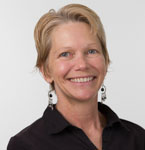 As new Membership Committee Chair I want to send a warm welcome and briefly introduce myself. In my home UU church in Hobart, IN, I held a number of committee positions including Finance, RE, and Stewardship and served on the Board as member and also President. I attended a weeklong UU training (Midwest Leadership School in Beloit, WI). I served briefly on a UUA Committee on Appraisal and also was a Central Midwest District Consultant for a few years, facilitatingBoard retreats, etc. As an introvert, I might never have opted to do any of
As new Membership Committee Chair I want to send a warm welcome and briefly introduce myself. In my home UU church in Hobart, IN, I held a number of committee positions including Finance, RE, and Stewardship and served on the Board as member and also President. I attended a weeklong UU training (Midwest Leadership School in Beloit, WI). I served briefly on a UUA Committee on Appraisal and also was a Central Midwest District Consultant for a few years, facilitatingBoard retreats, etc. As an introvert, I might never have opted to do any ofQuotes About Letting Go
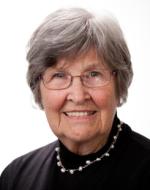 Bettye Barclay has provided this list of quotes about our ministerial theme for October. Daily quotes also appear in the weekly electronic announcements.
Bettye Barclay has provided this list of quotes about our ministerial theme for October. Daily quotes also appear in the weekly electronic announcements.
UU COMMUNITY CHURCH OF SANTA MONICA: SEPTEMBER 28, 2015 TO JANUARY 5, 2016
Frequently Asked Questions About Our Minister’s Sabbatical
Warren Mathews Conference Room Dedicated

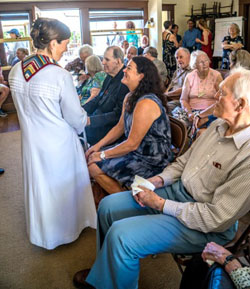
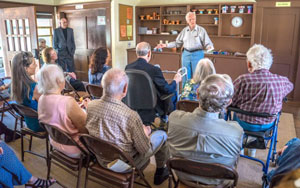
Quotes About Forgiveness:
 Bettye Barclay has provided this list of quotes about our ministerial theme for September. Daily quotes also appear in the weekly electronic announcements.
Bettye Barclay has provided this list of quotes about our ministerial theme for September. Daily quotes also appear in the weekly electronic announcements.
Week 1. Forgiveness means letting go of the past. — Gerald Jampolsky
Week 2. When you hold resentment toward another, you are bound to that person or condition by an emotional link that is stronger than steel. Forgiveness is the only way to dissolve that link and get free. — Katherine Ponder
Week 3. A happy marriage is the union of two good forgivers. — Robert Quillen
Week 4. The willingness to forgive is a sign of spiritual and emotional maturity. It is one of the great virtues to which we all should aspire. Imagine a world filled with individuals willing both to apologize and to accept an apology. Is there any problem that could not be solved among people who possessed the humility and largeness of spirit and soul to do either — or both — when needed? — Gordon B. Hinckley
Week 5. Let us forgive each other — only then will we live in peace. — Leo Nikolaevich Tolstoy
UU Humor
(from the First Unitarian Congregation of Ontario)
Q. What is a Unitarian Universalist?
A. Someone who believes in life before death.
A. Someone who faces all questions with an open mouth.
Q: How many Unitarians does it take to change a light bulb?
A: We choose not to make a statement either in favour of or against the need for a light bulb. However, if in your own journey, you have found that light bulbs work for you, that is wonderful. You are invited to write a poem or compose a modern dance about your personal relationship with your light bulb. Present it next month at our annual Light Bulb Sunday Service, in which we will explore a number of light bulb traditions, including incandescent, fluorescent, 3-way, long-life, and tinted, all of which are equally valid paths to luminescence.
A UU is told “I hear you deny the divinity of Christ.” “That’s not true!” said the UU, “We don’t deny the divinity of anyone.”
Q: Why can’t UUs sing very well in choirs?
A: Because they’re always reading ahead to see if they agree with the next verse.
Q: Why did the UU cross the road?
A: To support the chicken in its search for its own path.
“I know my humor is outrageous when it makes the Unitarians so mad they burn a question mark on my front lawn.” — Lenny Bruce
Q: How does a UU walk on water?
A: She waits until winter.
Visitors on a tour of Heaven noticed a group of Unitarian Universalists, who were arguing about whether or not they were really there.
“A Unitarian very earnestly disbelieves in almost everything that anybody else believes, and he has a very lively sustaining faith in he doesn’t quite know what.” — Somerset Maugham, Of Human Bondage
Unitarian Universalist prayer: “Dear God, if there is a God, please save my soul, if I have a soul.”
A Unitarian Universalist died, and to his surprise discovered that there was indeed an afterlife. The angel in charge of these things told him, “Because you were an unbeliever and a doubter and a skeptic, you will be sent to Hell for all eternity—which, in your case, consists of a place where no one will disagree with you ever again!”
 Past President Cynthia Cottam, President Patricia Wright, Summer Minister Nica Eaton-Guinn, and the Rev. Dr. Ken Brown at a workshop on governance held at the church on Saturday, July 11. Photo by Charles Haskell.
Past President Cynthia Cottam, President Patricia Wright, Summer Minister Nica Eaton-Guinn, and the Rev. Dr. Ken Brown at a workshop on governance held at the church on Saturday, July 11. Photo by Charles Haskell.
The Rev. Dr. Ken Brown’s Governance Workshop
By Steve White
The Rev. Dr. Ken Brown, at our Board’s invitation, presented a three-hour “Governance Workshop” on Saturday, July 11. All nine board members were present, as was our Summer Minister. Also present were 15 other church members (a mix of new members and long-time members, most of whom have served or are serving in leadership roles in the church).
Ken is on the UUA Staff, for the last 16 years serving, alongside of Tera Little, our sabbatical minister this coming fall, as the Congregational Life Specialist for the Pacific Southwest District, the group of 50 UU churches in Southern California and Arizona. He noted that the PSWD board and staff have moved toward policy-style governance over the last few years. He serves as one of the consultants to district churches and presents numerous workshops on common church-related topics. He became a UU minister 41 years ago, and served several congregations around the U.S. for twenty-some years before joining the UUA staff.
He noticed the “Coming of Age Covenant” on the wall of the classroom: “To Be Present, To Have Fun, Not to Be Too Hard, No Laughing at One Another, Respect Other People’s Opinion, Listen to Each Other, No Phones, Step Up/Step Back, Judgment Free” as a good example of a covenant, as opposed to a creed. He reminded us that we are a covenantal faith and that developing covenants is an important aspect of our UU tradition. Throughout his talk, Ken returned regularly to the importance of talking among ourselves and always dealing with each other and issues in a relational way.
He described boards as having five basic functions: 1) develop & hold up mission/vision statements, 2) define policy, 3) develop a strategic plan, 4) provide for financial responsibilities and 5) perform ongoing assessments. He said that the role of the board was to make sure that essential things happened, such as fundraising. He noted that leadership in UU churches is hard work, especially as we place a high value on “process.”
The most-often neglected board function is “assessment” — the ongoing monitoring of all church functions, activities, and processes as compared to the policies that describe them, in relation to advancing the mission and ministries of the church. Well-thought-out assessment tools are required. He did not think that assessments should be done anonymously, but rather that people should convey their assessments by speaking out and discussing them with each other. An opinion is not worth much if it does not have a person attached to it. He recommended that assessments be done by “focus groups,” specifically including newcomers and limiting the role of elders, while always asking “Who’s Missing?” Ken distinguished “assessment” from “evaluation,” relative to “honest oversight.”
Ken said that the book “Governance and Ministry — Rethinking Board Leadership” (2009) by Dan Hotchkiss, a UU Minister and Alban Institute senior consultant, was the source of many of the ideas about governance being considered by or already adapted for the UUA and many UU churches. [Note: Our President, Patricia Wright, made copies of this book available to the congregation last fall. Since then the Board has devoted substantial time over several board meeting studying various chapters in order to become well informed about whether to further explore changes to our congregation’s governance.] Several who have read the book noted that it offers a wide range of possibilities, some of which we already use in our congregation’s organization, stating that UU Santa Monica’s style of organization is already a type of policy-style governance.
He defined “governance,” as embodied in “policies,” as defining the relationships and authority among the various parts of the church organization, whereas the bylaws describe the components of the organization by defining basic rules, such as how one becomes a member, procedures for calling and dismissing ministers, requirements for electing board members, and procedures for approving a budget. Bylaws should be minimalist. He stated that “policies” are defined and modified by the board, not the congregation, with bylaws limited to a few basic matters. The group found this to be a difficult distinction. Governance by policies is intended to empower the people of the congregation to conduct the ministry of the congregation and fulfill our mission. Policy is about the relationships and roles within the church. For example, how does the minister relate to the staff? Ken admitted that development of policies is very difficult. The group struggled to understand his statements. For instance, policies set the “big picture”; you can carry out the ministry of the church “within these boundaries,”then the committees are freer to plan their activities. They do not have to go to the board for approval of everything as long as they function within the boundaries of the policies. Policy governance gives more liberty to the committees, their activies are not so restricted by the board. The board’s role is enforcement within the limits or boundaries set by the policies.
Mid-size churches such as ours, with 338 members, often move towards “policy-style” governance. [Note: “Policy Governance” is a registered trademark for specific secular rules created by John Carver. John Carver is an adjunct professor in the Institute for Nonprofit Organizations at University of Georgia School of Social Work.] Ken Brown warned of the perils of taking Carver’s ideas too literally, specifically his rule that the minister should be the Chief Executive Officer (CEO) of the church. According to Ken, “governance by policy” does not mean that the minister becomes the CEO of our congregation. Patricia, our President, stated that this is not the intent of our Board. A UU minister is more of a facilitator, not a CEO. Ken noted that in UU churches the minister “has no authority to tell people what to do” but rather facilitates processes. The facilitative role of the minister is to help empower people to get going or to help them relate, for instance, by promoting awareness of the UU Seven Principles and enabling us to implement them in our ways of relating to one another. Ken was adamant that “in no way is the role of the minister to be over anyone.” A number of people expressed that they did not want the minister to function in our congregation as a CEO.
A member asked “Why?” — what problems or issues prompted the Board’s interest in studying and possibly changing our governance? A specific UU Santa Monica response was pre-empted by Ken proceeding to address how to determine whether a church needs changes to its governance He cited some circumstances: 1) “most congregations don’t know how they are governed”; 2) reduce ambiguity and frustration by simplification; and, 3) provide a means to deal with conflicts, for instance, if rudeness and personal criticism have become common. A sense that our church is having conflict was brought up a number of times in a number of contexts by the group. In one instance, someone asked if our church should be dealing with changing our governance while we have so much conflict. About this, Ken said that “you must deal with conflict while dealing with governance.” He also suggested that some changes were needed to reflect the expanding roles of most UU ministers in church management and operations. Tweaking of policies and bylaws and adapting some policy governance ideas is what most UU congregations have done. Patricia said that this is what our Board seeks to explore. Ken stated that, in general, 80% of the members of most congregations have no interest in governance and simply want to have good Sunday services and a good RE Program. At most, 20% are involved or interested, with perhaps another 10% having some mild curiosity. [Note: about 120 of our 330 members at the time (36%) participated in our latest Annual Business Meeting in person, by absentee, or by proxy. In the fall of 2009, the Settled Minister Search Committee Congregational Survey had 209 responses, about 50% of our congregation at the time.]
One attendee stated that she doesn’t feel heard, that despite being a long-time member, she feels ignored and excluded by “insiders.” Another long-time member said she felt not heard, condescended to, and not given explanations by leaders. Ken said it is the board’s responsibility to listen to the congregation and transparency must be at all levels. Ken said that there needs to be a place for people to feel heard. He recommended establishing a “Covenant of Right Relations,” defining a process for setting and assessing boundaries, providing a respectful place where it is OK to be candid, as well as providing other processes for maintaining constructive behaviors. He noted that “transparency”can take many forms, as it is the conversation between the board and the congregation. Transparency is providing information to everybody by multiple means. [Note: there is a gap between what our leaders have regarded as “transparent” and the expectations of some church members, a difference that should be explored.]
Ken suggested that one means of opening the board processes and discussions to the congregation is for the board to hold open meetings after services on a quarterly basis, rather than rely entirely on monthly newsletter columns. This idea met with much approval, although some noted the loss of efficiency. The board should publicize its agenda and goals and invite participation. He then stated that board meetings should never last more than two hours; longer meetings indicate a lack of focus, lack of delegation, and unclear governance procedures. This idea was met with enthusiasm. Some past presidents stated that their board meetings had never lasted more than two hours.
One element of “policy-style” governance might be the transformation from our current administrative and other committees into about six “Ministry Teams.” Within “boundaries” set by policies and budgets, the groups are empowered to “do ministry” without needing to obtain board approval. This is intended to enable new ideas and initiatives to be started more easily, without frequently having to go to the board for approval. [Note: This is somewhat different than the way we in Santa Monica currently do things, as some committees often do come to the Board with proposals for approval, while others do operate more independently.] The goal of governance by policy would allow more freedom for all committees to do independent work on the “ministry” of the congregation. [Note: A distinction must be made between board committees (finance, personnel, stewardship/pledge) and activity/affinity groups, which although referred to as “committees”, are functionally “task forces” or “programs.”]
Ken contended that strong policies provide continuity, so that church functions don’t depend entirely on the style and interests of whoever is Board President. A past president contended that the purpose of the our Bylaws was precisely to provide that continuity, much like our Constitution protects the citizens from departures from our principles attempted by the President or the Congress. Policies can limit the common inclination of volunteer leaders to micro-manage.
Ken presented a diagram by William Bridges of the process of change over time. [Note: William Bridges was an organizational consultant who emphasized the importance of understanding transitions as a key for organizations to succeed in making changes.] Change is always with us, but we get stuck in transitions. Successful change requires gut/ emotional levels of conversation after defining what, where, and how, moving from personalities to issues. Sometimes a few loud voices block change. [Note: on the other hand, members with concerns often remain quietly on the sidelines, not wanting to raise questions that might provoke controversy and challenge our ability to “dwell together in peace.”] Some attendees noted that very little governance communication happens outside of Board meetings.
Another important, but often neglected, board function is leadership development. He advocated replacing the Nominating Committee, active only from January to May, with a year-round Leadership Development team. He stated that the personal interests, experience, and skills required at each level (member, committee member, chair, board member) are not the same, with someone eager to run a program not necessarily having the broad experience and perspective appropriate to a board member.
However, the spouse of a long-time member of the Nominating Committee said that this model is not even close to how the committee actually functions. He said that often well-qualified choices for leadership roles decline the nomination, leaving the Nominating Committee more and more anxious for some willing, dutiful members to step forward, often after protesting that they are unqualified. As a consequence, new Board members may struggle until they have learned the ropes. They need to learn what is expected of Board members, how the church is organized, what the policies and procedures are that guide the church’s activities, and to learn the recent history of the Board so they understand the context of decision making at the Board level. [Note: However, this broader recruitment net often leads to the inclusion of a wider variety of members, who grow into effective leaders. An analysis of why many decline to take on leadership roles, as well as clarification of the roles, might lower the perceived barriers to serving.]
All in attendance regarded the workshop as stimulating, thought provoking, and a good start to further discussions about healthy processes for defining, evaluating, and gaining consensus about possible appropriate changes.
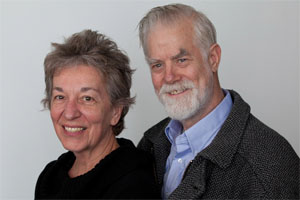 Steve White is a Past President of our congregation. He served as the scribe for the Committee on Money during the 2014- 2015 church year. He currently serves as Chair of the Membership Committee. His wife, Sue Stoyanoff, is co-chair of the Committee on Ministry. Contributors to this article were Patricia Wright, Nica Eaton-Guinn, Beth Brownlie, Rick Teplitz, and Diane Fletcher-Hoppe. Editorial comments were received from Ken Brown, Kit Shaw, Joe Engleman, Kim Miller, Sue Stoyanoff, and Charles Haskell.
Steve White is a Past President of our congregation. He served as the scribe for the Committee on Money during the 2014- 2015 church year. He currently serves as Chair of the Membership Committee. His wife, Sue Stoyanoff, is co-chair of the Committee on Ministry. Contributors to this article were Patricia Wright, Nica Eaton-Guinn, Beth Brownlie, Rick Teplitz, and Diane Fletcher-Hoppe. Editorial comments were received from Ken Brown, Kit Shaw, Joe Engleman, Kim Miller, Sue Stoyanoff, and Charles Haskell.
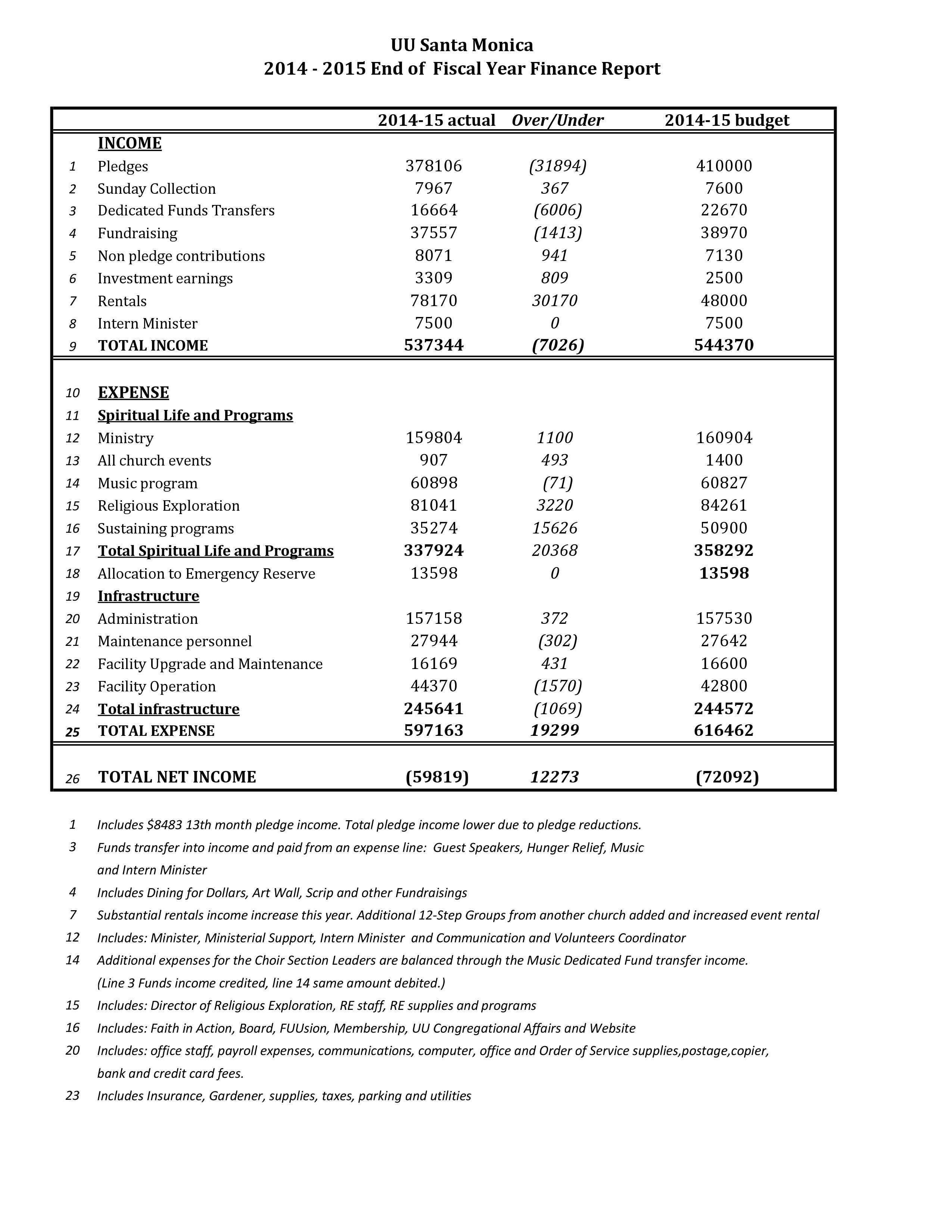
The Annual Interweave / Women’s Alliance Picnic
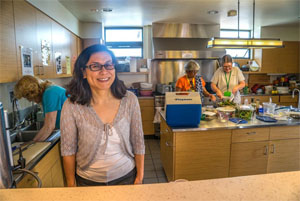
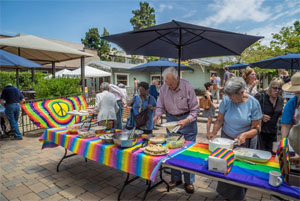
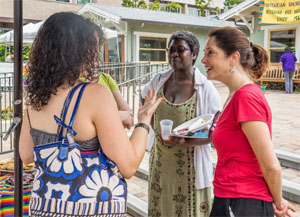
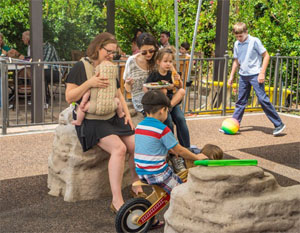
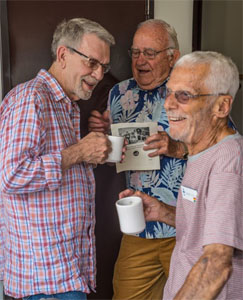
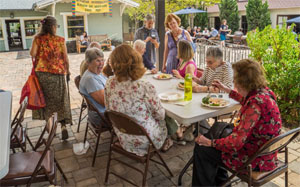

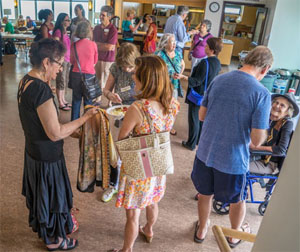
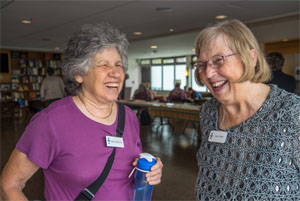
Quotes About COMPASSION
 Bettye Barclay has provided this list of quotes about our ministerial theme for August. Daily quotes also appear in the weekly electronic announcements.
Bettye Barclay has provided this list of quotes about our ministerial theme for August. Daily quotes also appear in the weekly electronic announcements.
Week 1. Some people think only intellect counts: knowing how to solve problems, knowing how to get by, knowing how to identify an advantage and seize it. But the functions of intellect are insufficient without courage, love, friendship, compassion, and empathy. — Dean Koontz
Week 2. Love and compassion are necessities, not luxuries. Without them humanity cannot survive. — Dalai Lama
Week 3. The dew of compassion is a tear. — Lord Byron
Week 4. The individual is capable of both great compassion and great indifference. He has it within his means to nourish the former and outgrow the latter. — Norman Cousins
Week 5. Give children at least as many chances to be compassionate as they have to be competitive. — Erica Layman
The Supreme Court Stands on the Side of Love!
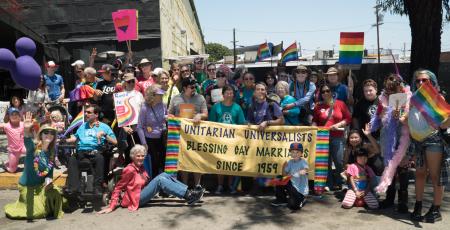 Group photograph of UU Santa Monica’s marchers in the L.A. Pride Parade on June 14. On June 24 the Supreme Court ruled that same-sex marriage is constitutional and that it is now the law of the land. Photo by Dalia Al Kassar
Group photograph of UU Santa Monica’s marchers in the L.A. Pride Parade on June 14. On June 24 the Supreme Court ruled that same-sex marriage is constitutional and that it is now the law of the land. Photo by Dalia Al Kassar
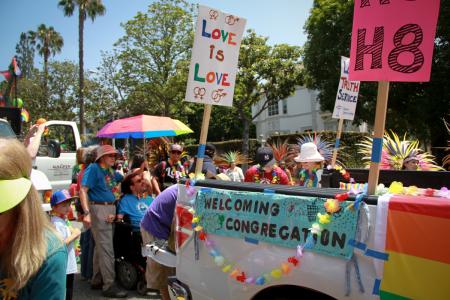
Our UU Santa Monica marchers had a truck to carry weary marchers and those who were unable to walk. Photo by James Witker.
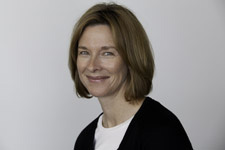 Heart to Heart Circles — Always an Open Seat
Heart to Heart Circles — Always an Open Seat
“Small Group for me is an opportunity for inner landscapes and shared stories about life’s meaningful moments.” -Carrie Lauer, Heart to Heart Facilitator
“The Heart to Heart Circle is a bright spot in my month, giving me a time for deep reflection and attention to personal meaning-making. My life is very full of time spent caring for others — this is a lovely time of caring for myself, in a supportive and loving circle.” -Catherine Loya, Heart to Heart Facilitator
Our Heart to Heart Circles (formerly known as Small Group Ministry) are in full swing! For 2015 we have six groups meeting monthly. Heart to Heart Circles are a space where participants gather to speak from the heart and to listen deeply to others speak from the heart. We have a monthly topic, which is usually the church theme for the month, along with selected readings and questions to consider about the topic. The goal is to connect in a meaningful way with those in the circle, and to connect more deeply to one’s self. It’s a unique meeting in that there isn’t a back and forth discussion; we’re not there to “fix” anyone or give advice. In addition to our heartfelt meetings, each group does a service project for the church and one for the wider community.
Often people seek a church community in order to find deeper meaning in their lives and to find relationships with others who share their values. For people new to the church community, Heart to Heart Circles offer an opportunity to form friendships with others and to more easily become involved with the church. In each of the Heart to Heart Circle meetings we have an empty chair. This chair symbolizes the person yet to participate; it reminds us that our circle is open to others. Perhaps you missed the initial registration in January and you’d like to become part of the Circle? Let us know — we’d love to welcome you! Groups meet once a month for two hours. Five of our groups meet during the week in the evening, and there is one daytime group. Contact sgm@uusm to get more information or to participate in a group.
— Rhonda Peacock

Heart to Heart Circles facilitators for 2015-2016: Rev. Rebecca Benefiel Bijur, Margot Page,Pat Gomez, Phillip Bonacich, Bettye Barclay, the Rev. Carrie Lauer, and Catherine Farmer Loya. Photo by Carol Ring.
Quotes About Creativity
 Bettye Barclay has provided this list of quotes about our ministerial theme for July. Daily quotes also appear in the weekly electronic announcements.
Bettye Barclay has provided this list of quotes about our ministerial theme for July. Daily quotes also appear in the weekly electronic announcements.
Week 1. The chief enemy of creativity is “good” sense. — Pablo Picasso
Week 2. Creativity is merely a plus name for regular activity. Any activity becomes creative when the doer cares about doing it right or better. — John Updike
Week 3. Imagination is more important than knowledge. For while knowledge defines all we currently know and understand, imagination points to all we might yet discover and create. — Albert Einstein
Week 4. Imagination is the beginning of creation. You imagine what you desire, you will what you imagine and at last you create what you will. — George Bernard Shaw
Week 5. When I am working on a problem I never think about beauty. I only think about how to solve the problem. But when I have finished, if the solution is not beautiful, I know it is wrong. — Buckminster Fuller
Highlights from our 88th Congregational Meeting
 Ron Crane discussing the report of the Committee on Money and responding to a question from Melinda Ewen at the microphone during our 88th Annual Congregational Meeting on May 17. An additional photograph from this meeting appears on page 3. Photo by Charles Haskell.
Ron Crane discussing the report of the Committee on Money and responding to a question from Melinda Ewen at the microphone during our 88th Annual Congregational Meeting on May 17. An additional photograph from this meeting appears on page 3. Photo by Charles Haskell.
• The meeting was extremely well attended and lasted about three and a half hours. Issues were discussed with vigor and a deep concern for the welfare of the church (97 present, 19 proxy ballots, 9 absentee ballots).
• We elected a new Board and Nominating Committee.
• We were informed that the Board plans one or more educational sessions on the recommendations of the Committee on Money, followed by a congregational business meeting. After discussing the issue for an hour and a half the congregation voted resoundingly that this business meeting is to occur no later than February 15, 2016 (76 yes, 6 no, 1 abstention).
• We approved a budget that calls for the transfer of funds from a variety of restricted reserve accounts and from our unrestricted reserves to help cover projected expenses. The budget reflects a growing appreciation that we need to look at our budget from a more global perspective, taking into account the prudent use of all our resources.
• We approved the “Arizona Garden Project” design, installation, and fund raising proposal. This will become the “Garden of Eternity,” which will include the opportunity to purchase memorial bricks to help us remember loved ones.
— Charles Haskell
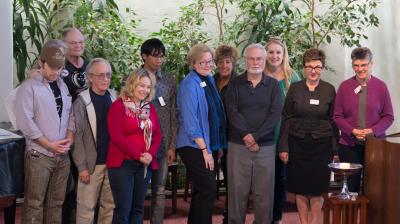
Members of the Board and Nominating Committee
(Left-to-right): James Witker, Beth Rendeiro, Rick Rhoads, and Bob Dietz (Nominating Committee). Beth Brownlie (Member-at-Large), Leonard Cachola (Secretary), Rebecca Crawford (Board Member-at-Large), Wendi Gladstone (Nominating Committee), Joe Engleman (Member-at-Large), Kim Miller (Treasurer), Patricia Wright (President), and Cynthia Cottam (Past President). Nominating Committee member not shown: Gretchen Goetz. Board members not shown: Dan Nannini and Emily Hero. Photo by Charles Haskell.
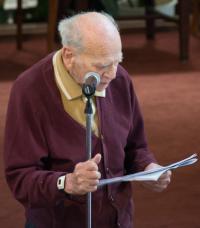
Ray Goodman spoke at our annual meeting on behalf of the motion to establish a “Garden of Eternity” as part of our “Arizona Garden Project” design. Photo by Charles Haskell.
Make June Your 13th Month and Help Bridge the Gap!
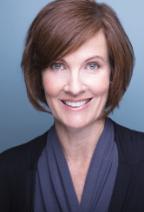 Many families in our community make monthly gifts to the church to support our ministry and mission: to love generously, seek truth, and serve the world. We depend on these monthly gifts, combined with your generous annual and weekly contributions, to provide about 75% of our total funding as an organization.
Many families in our community make monthly gifts to the church to support our ministry and mission: to love generously, seek truth, and serve the world. We depend on these monthly gifts, combined with your generous annual and weekly contributions, to provide about 75% of our total funding as an organization.
As we approach the last month of our church fiscal year, we are nearly $35,000 short of the annual gifts (pledges) our members and friends had committed this year—that is, funds our community pledged to support the church, but were unable ultimately to contribute.
Can you help us bridge the gap with a “13th Month” gift before June 30? The 13th Month is a gift about the size of what you’d otherwise give to the church each month, or, a gift of $100, $50, or even $20 per household. We hope you’ll join us in making a 13th Month Gift toward our first-ever 13th Month Campaign.
It’s easy since we have several ways to make a gift; visit our Make a Donation page online at uusm.org/make-a-donation, mail or deliver a check with the memo “13th Month” to the church office, or simply add a cash gift labeled “13th Month” to the Sunday offering.
Thank you for helping us bridge the gap and close out our fiscal year with a bang!
Your Pledge Team: Teri Bond, Abby Arnold, Rev. Rebecca, Kit Shaw, Barbara Gibbs, Patricia Wright, and Gretchen Goetz
Quotes About Mercy
 Bettye Barclay has provided this list of quotes about our ministerial theme for June. Daily quotes also appear in the weekly electronic announcements.
Bettye Barclay has provided this list of quotes about our ministerial theme for June. Daily quotes also appear in the weekly electronic announcements.
Week 1.
I have always found that mercy bears richer fruits than strict justice. — Abraham Lincoln
There is no austerity equal to a balanced mind, and there is no happiness equal to contentment; there is no disease like covetousness, and no virtue like mercy. — Chanakya (371 BC-283 BC)
Week 2.
Amnesty is as good for those who give it as for those who receive it. It has the admirable quality of bestowing mercy on both sides. — Victor Hugo
Sweet mercy is nobility’s true badge. — William Shakespeare
Week 3.
Understanding the brokenness of other people and the pressures they experience makes it easier to be merciful. Mercy is ultimately tied to compassion and empathy. — Unknown
Computers are like old testament gods; lots of rules and no mercy. — Joseph Campbell
Week 4.
I see that the path of progress has never taken a straight line, but has always been a zigzag course amid the conflicting forces of right and wrong, truth and error, justice and injustice, cruelty and mercy. — Kelly Miller
You will achieve more in this world through acts of mercy than you will through acts of retribution. — Nelson Mandela
FAQ: LA Pride Parade on Sunday, June 14
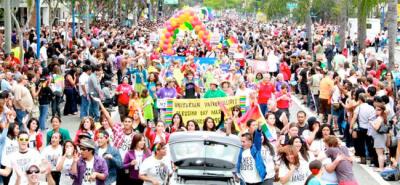 1. How can I get to the parade?
1. How can I get to the parade?
To make it easier and to promote participation, we are chartering a bus to take 56 people from our church to the parade and bring them back after we march. We are asking $15 round trip but we can arrange a family discount. The bus will leave 18th and Arizona Ave. after the 9 a.m. service (about 10 a.m.) and return to UU Santa Monica around 2 to 2:30 p.m. Please don’t wait to reserve your spot! Contact Janet Goodwin at Goodwin@ucla.edu or sign up at the Interweave table after service. And if you can sponsor yourself and another person, we’d love to be able to offer some discounts or free rides to those who need it.
2. What if I want to drive?
If you choose to drive (and some of you will HAVE to because we want way more than 56 people!), you’ll want to park near the END of the route near Santa Monica Blvd. and Robertson. There will be some street parking and during the parade ALL parking meters in West Hollywood are FREE so the posted rules don’t apply (just for West Hollywood, though, not Hollywood) and also the Pacific Design Center has a parking structure, but it’s not free. It’s about a 15-minute walk to the head of the parade (see it’s a REALLY short distance).
3. What is the exact parade route?
The parade route begins at the intersection of Santa Monica and Crescent Heights along Santa Monica Blvd. to Robertson Blvd. The route is 1.2 miles and takes maybe an hour and a quarter maximum at a leisurely “parade” pace. The staging area (where we meet to line up) consists of the 3 feeder streets: Crescent Heights (north and south of “stepoff”) and Santa Monica (east of “step-off”). I will receive more precise information about where our group will line up when I attend the safety workshop in early June.
4. What time do we meet?
By about 10:45 a.m. is good. If you park near the end of the parade (Santa Monica and Robertson), you need to factor in a 15-minute walk to the parade. Just call me that morning to get an update. Even though we won’t start until after 11 a.m., it’s still FUN to be together and to see the other marchers. If you’re late, just call us and you can try to join us en route.
5. What time do we march?
I will get a “number” when I check us in the morning of the parade on June 14. That number tells us how many units/ floats/groups are in front of us. The first group will start moving at 11 a.m. and although we won’t know until we check in on Sunday exactly what our start position will be, as I said above, I am hopeful that we’ll be in the first hour of marchers.
6. What does our “unit” consist of?
This year we are again renting a pickup truck. If you come early enough, you can help us decorate it. It will be moving slowly — with us marching beside/behind it. We have also invited other local UU marchers from the LA area to join us. We also have multiple banners — the “UU Santa Monica standing on the side of love” one and another that Debbie Menzies made (Unitarian Universalists Blessing Gay Marriages Since 1959). The Sepulveda UU Society has typically brought the official “Standing on the Side of Love” banner, too. Traditionally, we’ve used banners to define the beginning and end of our “unit.” However, the vehicle will probably be at the head of our group. We encourage every congregation to bring a congregational flag if they have one. Many of us also carry signs with a supportive message: “We teach love not hate.” “Service is our prayer.” “ Love is love.” “No H8.” Feel free to make one and bring it!
7. What should I wear?
Any colorful shirt is FINE. I try to bring a few extra in various sizes but any colorful shirt or tie-dyed shirt or UU shirt or Standing on the Side of Love shirt would be fantastic.
8. What should I bring?
• Your cell phone (if you have one) and it might be a good idea to add our numbers to your contact list
• Water bottle
• Sunscreen
• Hat
• A little rainbow flag if you have one
• Colorful leis, if you have them
• Sign with a supportive UU message
Just to give you an idea of the pride experience, here’s a video made by a group of UU churches in Dallas: http://vimeo.com/49690449
Wouldn’t you like to be part of a similar group here in LA? Join us on Sunday, June 14, as we stand on the side of love, equality, and justice for all.
— Janet Goodwin

